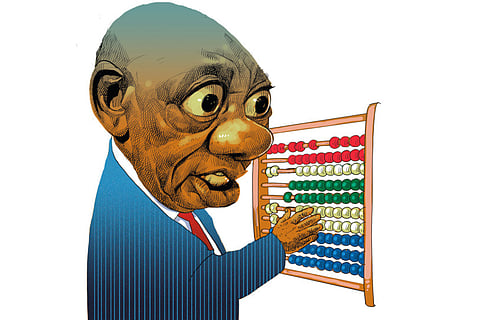A new deal for South Africa
For Ramaphosa, recapturing the economic narrative is the only way to return hope to the majority of the people

A month has passed since Cyril Ramaphosa, the head of the African National Congress (ANC), replaced Jacob Zuma as South Africa’s president. Ramaphosa, a former protege of Nelson Mandela, has reinvigorated the country with his competence and commitment to transparency. For this reason alone, South Africans have cause for optimism.
But while South Africa has taken the road less travelled — bucking the global trend toward populism and authoritarianism — the country remains at a crossroads. Zuma’s departure did nothing to address the imbalances that are undermining the economy. If South Africa is truly to turn a corner, inequality must be addressed; the majority of the country’s citizens must believe that they can achieve a brighter future.
In South Africa, poverty, inequality, and ethnicity overlap, to the disadvantage of a majority of the country’s 57 million people. With a per capita income of $13,000 (Dh47,710) last year (measured by purchasing power parity), South Africa is a middle-income country similar to Brazil, Mexico, and Thailand. But the headline figure masks a level of inequality that is particularly acute.
For example, in 2010, South Africa’s richest 10 per cent accounted for 53 per cent of total consumer spending. Compare this to Brazil in 2000, when the richest 10 per centof Brazilians accounted for 47 per cent of total household spending. At the time, that made Brazil one of the world’s most unequal middle-income states. While Brazil’s income gap has closed slightly since then — as has Mexico’s and Thailand’s — South Africa’s has not.
In the absence of a strong middle class, most South Africans during Zuma’s tenure were either rich or poor. In 2010, the country’s poorest 40 per cent accounted for just 6.9 per cent of the country’s total expenditures. In 2016, 17 million people needed government assistance to make ends meet. And while South Africans earn, on average, four times more than low-income Kenyans, that is only one-fifth of what the average American earns.
Inequality has had a corrosive effect on South Africa’s public and private institutions, negatively affecting how wealth is generated. Immediately after apartheid ended, the removal of discriminatory hiring practices opened new routes to prosperity for many black South Africans. Some ANC leaders took corporate jobs, while other South Africans benefited from laws meant to encourage black economic empowerment.
But in the Zuma era, concentrated wealth led to nepotistic hiring practices, political appointments based on clientelism (owing to higher salaries for government employees), and other forms of corruption. An exclusionary labour aristocracy emerged, further deepening patronage networks within the public sector. The capacity of government to provide services weakened. So, while the top one-third of the population continued to do quite well, the sense of possibility that the vast majority of South Africans had felt at the dawn of the country’s post-apartheid democracy was disappearing.
To be sure, states have wrestled with inequality for as long as wealth has been generated. In 1973, the development economist Albert Hirschman likened Latin America’s struggles with inequality to drivers stuck in a traffic jam. Hirschman argued that when one lane of cars begins moving, people in the other lane “feel much better off,” because they expect to move soon, too. Similarly, poor people in a growing economy tolerate inequality for a while, because they believe “that eventually the disparities will narrow again.” As long as people are confident that the gridlock will eventually clear — that a better future awaits — they can put up with temporary immobility. If the traffic never moves, “there is bound to be trouble and, perhaps, disaster.”
The ANC’s promise of a “better life for all” after the end of apartheid was the economic equivalent of an ostensible easing of the traffic jam. Eventually, South Africans lost faith in the repeated promise that more opportunities were coming. Zuma’s corrupt administration and economic mismanagement only deepened the public’s disillusionment.
For Ramaphosa, then, recapturing the economic narrative is the only way to return hope to the majority of South Africans. South Africa needs an inclusive “new deal” for the twenty-first century. To reinvigorate social mobility, South Africa also needs a dose of economic dynamism, buttressed by a strong social-safety net.
Executing such an agenda will not be easy. But South Africa’s institutions are up to the task of overcoming resistance by established elites. As Patrick Gaspard, the former United States ambassador to South Africa, recently noted, the country has a strong system of checks and balances that, if steered properly, can trump corruption and deliver needed reforms. With a strong civil society, a free media, robust political opposition, and an independent judiciary, South Africa is well positioned for a turnaround.
The challenges that Ramaphosa has inherited — rising inequality, a growing wage gap, and jobless growth — are not unique, even if they are extreme. But South Africa’s new leader does have an advantage: the country is eager for change. If economic stagnation continues, and if the challenges of expanding economic inclusion are not addressed, Hirschman’s theory of political ruin may become prescient. But if Ramaphosa succeeds in creating a new narrative that all South Africans can embrace, the road ahead can clear before voters seek a riskier alternative route.
— Project Syndicate, 2018
Brian Levy is Academic Director of the Graduate School of Development Policy and Practice at the University of Cape Town, and a professor of international development at the Johns Hopkins School of Advanced International Studies.
Sign up for the Daily Briefing
Get the latest news and updates straight to your inbox


